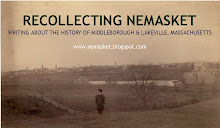.
There is little record regarding the original furnishings of the Green School, though it was undoubtedly furnished like a typical schoolhouse. The blackboard was the focal point of the Green school room and likely was situated on the rear wall opposite the entrances. In nearly constant use throughout the day, the blackboard required frequent repair and repainting. In 1877, the Green School’s blackboard was repainted by H. A. Sparrow, and it is likely that it was repainted with “liquid slating” in 1887. It was “thoroughly renovated” in 1906, repaired in 1910 by Eben Jones and again in 1912 by F. A. Johnson. In 1917, the board was resurfaced.
To write on the board, lumps of chalk known as “crayons” which differed from the slender cylindrical pieces common today were used.
A desk or table for the teacher likely stood at the rear of the building near the blackboard, and was used for her books, record cards, and as a resting place for the iconic hand bell. In 1886, Lorenzo Tinkham was paid $1.50 for a table for the building, though whether this was a replacement table for the teacher or a second table to help students with their studies is not known.
The students at the Green were originally provided with twenty double seats and desks which provided seating for forty students, just enough to accommodate all the students in 1881. These desks which were required to stand up to heavy use, were not always as durable as one wished. By 1881, just ten years after having been installed in the building, “several” were characterized as having “long been broken” and in need of replacement. Eventually, in 1904, the Green was furnished with adjustable seats and desks from the Chandler Chair and Desk Company at a cost of $161.00.
Adjustable desks had long been considered preferable to the previous seating options as indicated by Superintendent Jacoby in 1897:
Adjustable school furniture is far superior to the old line seats and desks, and no other should be bought. By its use it is no longer necessary to attempt the adjustment of the pupils to the seats and desks, but the seats and desks can be easily and properly adjusted to them. They are the best to buy on hygienic grounds, promoting , as they do, the physical growth and development of the puils, and the closer the adjustment the better will be the results. Being more comfortable, they are also more conducive to intellectual and moral growth and development; for one of the conditions of good work and conduct in school is physical comfort.
Despite the high praise adjustable desks received, there may have been some dissatisfaction with the new desks at the Green, for just two years later in 1906, Superintendent Bates was recommending they be renovated.
Sometime about 1884 a bookcase was probably installed in the Green Schoolhouse following the requirement by the state that school districts furnish pupils with free text books and supplies. The School Committee recommended in its report for 1883 the addition of these pieces of furniture to the local schoolrooms, and it was likely adopted. A more substantial piece of furniture arrived in 1903 when an organ was donated to the school for the use of students.
Also present in the room would have been a clock, a highly recommended article for instilling promptness in scholars. “We are more desirous of having clock-work in every school without exception. Such discipline is splendid, and obviates the need of frequent reproofs, or repeated punishments," noted the Middleborough School Committee in early 1873. The clock, however, was also an important tool for the teacher, helping her track the amount of time spent on each lesson.
Smaller articles in the building undoubtedly included galvanized pails - one with a dipper to be used for drinking water, and a second for cleaning - an ash pail and stove equipment, clothes hooks for clothing, shelving for lunch pails, cleaning tools such as a mop and broom, and doormats to eliminate the amount of dirt and mud tracked into the building.
While the Green School with its bare walls may have appeared initially somewhat spartan following its construction in 1871, in time this lack of decoration was addressed through the school adornment movement through which local schoolhouses were filled with suitable works of art of educational value including reproductions of noted paintings and busts of famous Americans. Superintendent of Schools Jacoby supported the movement stressing “what grand opportunities are here offered for private munificence!” It is not recorded what items may have been added to the Green School, though in many local one-room classrooms, pictures of Washington and Lincoln were commonplace.
NEXT PAGE: Heating & Ventilation
PREVIOUS PAGE: Construction
Subscribe to:
Post Comments (Atom)













+-+Copy.jpg)

+of+Smoky+Mountains+018.jpg)
No comments:
Post a Comment